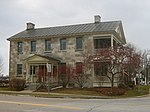Orange Vermont Senate District
The Orange Senate District is one of 16 districts of the Vermont Senate. The current district plan is included in the redistricting and reapportionment plan developed by the Vermont General Assembly following the 2020 U.S. Census, which applies to legislatures elected in 2022, 2024, 2026, 2028, and 2030. The Orange district includes most of Orange County. As of the 2020 census, the state as a whole had a population of 643,077. As there are a total of 30 Senators, there were 21,436 residents per senator. As of 2022, the Orange Senate District had 21,954 residents.As of the 2010 census, the state as a whole had a population of 625,741. As there are a total of 30 senators, there were 20,858 residents per senator. As of the 2000 census, the state as a whole had a population of 608,827. As there are a total of 30 Senators, there were 20,294 residents per senator. The Orange District had a population of 19,852 in that same census. The district is apportioned one senator. The district's 19,852 residents per senator is 2.18% below the state average.
Excerpt from the Wikipedia article Orange Vermont Senate District (License: CC BY-SA 3.0, Authors).Orange Vermont Senate District
Allen Road,
Geographical coordinates (GPS) Address Nearby Places Show on map
Geographical coordinates (GPS)
| Latitude | Longitude |
|---|---|
| N 44.7 ° | E -73.32 ° |
Address
Allen Road 59
05458
Vermont, United States
Open on Google Maps






